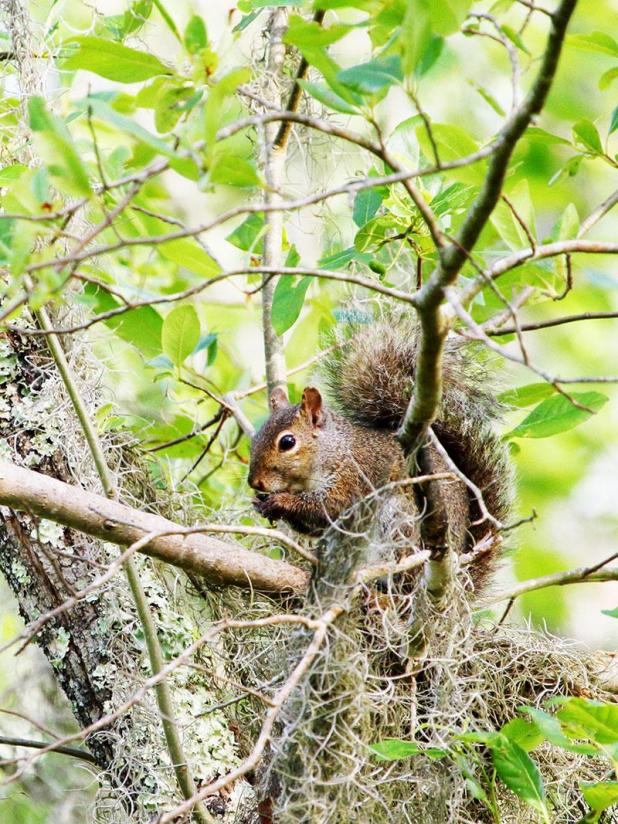
A gray squirrel feeds in the trees on Bayou Teche National Wildlife Refuge. (Submitted Photo/John K. Flores)
Small-game hunting preview for 2019-20
A number of years ago, there was a U.S. Coast Guard seaman stationed in Morgan City named Guy Morrow. Guy, his wife Sandra and their daughter were a precious family, roughly the same age of my wife and me. Our families went to the same church, and like many couples, we did things together, including having each other over for supper.
The thing about eating at our house is it’s “may the eater beware.” Beware, not because my wife isn’t a good cook. On the contrary, she’s an excellent cook.
No, the beware part is based on the fact that you never know what wild game meat you might be sitting down to eat at our place.
We had the Morrows over for dinner one Saturday afternoon that happened to be during the first weekend in October. In Louisiana, the first Saturday in October coincides with opening day of squirrel season.
On that particular Saturday, I shot a limit of eight squirrels. Plenty to feed both of our families. And no sooner had I cleaned them, my wife was smothering them down in a big black iron pot.
Guy had never eaten squirrel nor had Sandra. I don’t recall if Sandra or her daughter ate any, but I do remember the stack of bones on Guy’s plate. He literally, I am happy to say, made a pig out of himself and cleaned the pot.
Which brings me to the point of this little story: There may not be a better tasting game animal than pot-roasted squirrel.
The most recent Louisiana statistics from the 2012-2013 squirrel season indicate 50,700 small-game hunters bagged 872,100 squirrels, or roughly 17.2 squirrels per hunter. Put another way, each hunter basically shot two limits of squirrels per season.
All things considered, that’s not bad. What’s more, there certainly is no shortage of squirrels and plenty to harvest and eat.
There are two species of squirrels in Louisiana. The gray squirrel (Sciurus Carolinensis), which is the most common coastal marsh hunters chase in the fall and the fox squirrel (Sciurus Niger) found in the uplands. Both species do frequently overlap territories so take the specifics only in general.
Both species are omnivorous. Nuts (buried and unburied) like acorns, pecans and hickories are mast that dominates their diets during the late summer and fall. However, these critters also eat buds, beetles, bulbs, tubers, roots, berries, fruit, grain and even bird eggs. Basically, there’s no shortage of food sources that would disrupt populations.
In short, squirrels are more than abundant on the landscape where populations across the state are stable. Put another way, there’s plenty of fox and gray squirrels to fill black iron pots. All you have to do is go make a hunt.
Rabbit season should also reflect previous seasons. The bag limit remains eight per day. And the season, like squirrel, still runs from the first Saturday in October through the last day of February.
The 2012-13 small game study conducted by the Louisiana Department of Wildlife and Fisheries reported some 20,100 hunters bagged 180,100 rabbits statewide. Unlike squirrel, those numbers break down to basically single digits.
The problem with single digits is it’s a reflection of hunting opportunity. Much of Louisiana’s prime hunting real estate is behind locked gates. General public opportunities are often limited to wildlife management areas and national wildlife refuge systems.
There are two species of rabbits in Louisiana. The eastern cottontail rabbit (Sylvilagus Floridanus) is found in upland habitats. And the swamp rabbit (Sylvilagus Aquaticus) inhabits the marsh and bottomland hardwood swamps. Swamp cottontails are larger than their eastern cousins and darker in basic colors and the species most likely to be bagged in St. Mary Parish.
In spite of limited public access, good opportunities can be had by the small-game hunter willing to do a little homework. Kisatchie National Forest has some 604,000 acres available to some of the finest squirrel hunting available in the southeastern United States. I’ve hunted squirrel in Kisatchie. It is full squirrels.
Closer to home is Bayou Teche National Wildlife Refuge that offers over 9,000 acres of hunting opportunity, just in case you’re interested. All you need is a signed refuge permit and small game hunting license.
Other public lands with good-to-excellent squirrel- and rabbit-hunting opportunities include Attakapas, Atchafalaya and Sherburne Wildlife Management areas.
A review of wildlife management areas in the Louisiana Department of Wildlife and Fisheries Hunting Regulation Guide can be a tremendous help to hunters looking to harvest squirrels and rabbits on public land.
Rabbit and squirrel populations remain stable across the state. Weather-wise, conditions have been good, where mast crops and emergent and succulent vegetation is excellent along with plenty of herbaceous plant growth.
The outlook for this year’s small-game season is good. Now, all you need is a big black iron pot.
EDITOR’S NOTE: Flores is The Daily Review’s Outdoor Writer.
